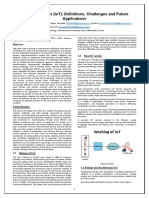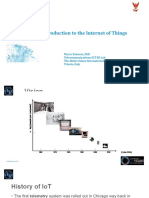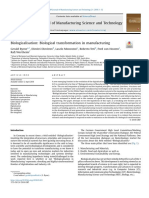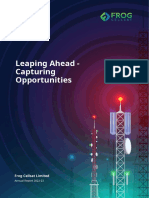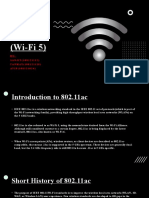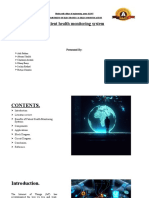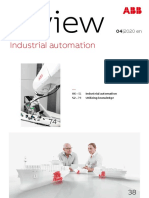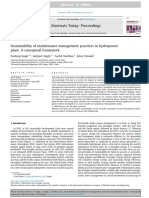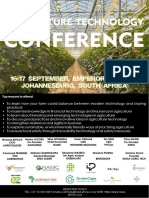IoT Unit 1
Introduction to the Internet of Things Definition & Characteristics of IoT, Genesis of IoT, IoT Impact
and Challenges
IoT Network Architecture and design: M2M IoT Architecture, IoT World Forum Standardized
Architecture, Simplified IoT Architecture, Core IoT Functional stack.
Application Domains of IoT: Smart Home, Smart Cities, Smart Environment, Logistics, Agriculture,
Industry, Health, and Lifestyle.
Introduction
Introduction to IoT:
- Vision of a connected world where everything communicates to enhance daily life.
- Examples include self-driving drones and health-monitoring clothing.
Definition of IoT:
- IoT is the collective term for the technological shift towards connecting previously unconnected
objects to the internet.
Basic Premise and Goal:
- "Connect the unconnected": Link objects not on a network to enable communication and
interaction.
- IoT transitions devices to make the physical world smarter through intelligent network
connections.
Benefits of IoT:
- Enables remote sensing and control of objects and machines.
- Tight integration of the physical world and computers for improved efficiency, accuracy,
automation, and advanced applications.
Complexity of IoT:
- Broad and multifaceted domain with various components and protocols.
- Viewed as an umbrella of concepts, protocols, and technologies, sometimes industry-dependent.
Challenges of IoT:
- Introduces new challenges like scaling devices and processing vast amounts of data.
- Despite benefits in productivity and automation, the diverse elements pose challenges in
implementation.
�Definition & Characteristics of IoT
Definition:
A dynamic global network infrastructure with self-configuring capabilities based on standard and
interoperable communication protocols where physical and virtual “things” have identities, physical
attributes, virtual personalities and use intelligent interfaces, and are seamlessly integrated into the
information network, often communicate data associated with users and their environments.
Characteristics:
Dynamic and self-Adapting: IoT devices and systems may have the capability to dynamically
adapt with the changing contexts and take actions based on their operating conditions,
user’s context, or sensed environment.
For example, consider a surveillance system comprising of a number of surveillance cameras.
The surveillance cameras can adapt their modes based on whether it is day or night.
Cameras could switch from lower resolution to higher resolution modes when any motion is
detected and alert nearby cameras to do the same. Here, the surveillance camera is adapting
itself based on the context and changing conditions.
Self-Configuring: IoT devices may have self-configuring capabilities, allowing large number of
devices to work together to provide certain functionality. These devices gave the ability to
configure themselves, setup the networking, and fetch latest software updates with minimal
manual or user intervention.
Interoperable Communication Protocols: loT devices may support a number of interoperable
communication protocols and can communicate with other devices and also with the
infrastructure. We describe some of the commonly used communication protocols and
models in later sections.
Unique Identity: Each IoT device has a unique identity and a unique identifier (such as an IP
address or a URI). IT systems may have intelligent interfaces which adapt based on the
context, allow communicating with users and the environmental contexts.
IoT device interfaces allow users to query the devices, monitor their status, and control them
remotely, in association with the control, configuration and management infrastructure.
Integrated into Information Network: IoT devices are usually integrated into the information
network that allows them to communicate and exchange data with other devices and
systems. IoT devices can be dynamically discovered in the network, by other devices and/or
the network, and have the capability to describe themselves (and their characteristics) to
other devices or user applications.
For example, a weather monitoring node can describe its monitoring capabilities to another
connected node so that they can communicate and exchange data. Integration into the
information network helps in making Iot systems "smarter" due to the collective intelligence
of the individual devices in collaboration with the infrastructure. Thus, the data from a large
number of connected weather monitoring loT nodes can be aggregated and analysed to
predict the weather.
�Genesis of IoT
The age of IoT is often said to have started between the years 2008 and 2009. During this time
period, the number of devices connected to the Internet eclipsed the world's population. With more
"things" connected to the Internet than people in the world, a new age was upon us, and the
Internet of Things was born.
The person credited with the creation of the term "Internet of Things" is Kevin Ashton.
While working for Procter & Gamble in 1999, Kevin used this phrase to explain a new idea related to
linking the company's supply chain to the Internet.
Kevin has subsequently explained that loT now involves the addition of senses to computers. He was
quoted as saying: "In the twentieth century, computers were brains without senses—they only knew
what we told them."
Computers depended on humans to input data and knowledge through typing, bar codes, and so on.
IoT is changing this paradigm; in the twenty-first century, computers are sensing things for
themselves.?
It is widely accepted that loT is a major technology shift, but what is its scale and importance? Where
does it fit in the evolution of the Internet?
As shown in Figure 1-1, the evolution of the Internet can be categorized into four phases. Each of
these phases has had a profound impact on our society and our lives. These four phases are further
defined in Table 1-1.
�IoT Impact and Challenges
Impact
Projections for the impact of IoT are significant, with only 0.06% of "things" currently connected to
the Internet, totaling around 14 billion.
Cisco Systems predicts a substantial increase to 50 billion connected devices by 2020, while a UK
government report speculates on a range of 100 billion connected objects. Cisco estimates that these
new connections could generate $19 trillion in profits and cost savings.
The essence of these projections is that IoT will revolutionize how individuals and businesses interact
with their environment. Real-time connectivity for managing and monitoring smart objects will
facilitate data-driven decision-making, optimizing systems and processes.
Ultimately, this will result in the delivery of new services that save time for individuals and
businesses, contributing to an enhanced overall quality of life.
1. Connected Roadways
People have been fantasizing about the self-driving car, or autonomous vehicle, in literature
and film for decades. While this fantasy is now becoming a reality with well-known projects
like Google's self-driving car, loT is also a necessary component for implementing a fully
connected transportation infrastructure.
loT is going to allow self-driving vehicles to better interact with the transportation system
around them through bidirectional data exchanges while also providing important data to
the riders. Self-driving vehicles need always-on, reliable communications and data from
other transportation-related sensors to reach their full potential. Connected roadways is the
term associated with both the driver and driverless cars fully integrating with the
surrounding transportation infrastructure.
2. Connected Factory
Traditional factories have long faced challenges due to disconnected and siloed production
environments, hindering visibility into operations and complicating issue resolution.
Key challenges include accelerating product introductions, improving production efficiency,
mitigating unplanned downtime, securing against cyber threats, reducing cabling costs,
enhancing worker productivity and safety.
Addressing these issues requires multi-level strategies across executive management,
product development, and plant management.
To overcome these challenges, industrial enterprises are adopting advanced technologies
and architectures, converging operational technologies with global IT networks to create
connected factories. This involves upgrading sensors and devices on the factory floor, making
them smarter, more connected, and capable of transmitting real-time data over Ethernet
infrastructure.
The rapid increase in numbers of Ethernet connectivity extends beyond main controllers to
include robots, video cameras, diagnostic devices, and personal mobile devices, contributing
to improved overall equipment effectiveness, supply chain responsiveness, and customer
satisfaction.
Challenges
��IoT Network Architecture and design:
M2M IoT Architecture
In 2008, the European Telecommunications Standards Institute (ETSI) established the M2M Technical
Committee with the aim of standardizing machine-to-machine (M2M) communications. Originally
focused on M2M applications and devices, the committee's scope expanded over time to include the
broader Internet of Things (IoT).
The goal is to facilitate efficient M2M communication systems and IoT by creating a common services
layer embedded in field devices. This layer supports communication with application servers and
focuses on various IoT services and applications such as smart metering, smart grid, smart city
automation, e-health, and connected vehicles.
�Difference Between IoT and M2M



















